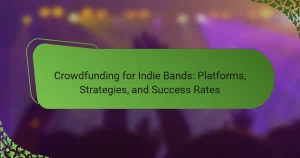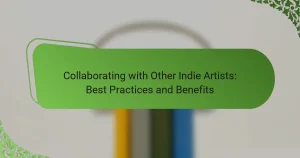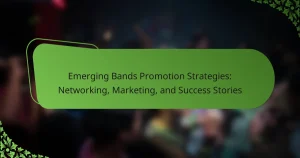Streaming services are transforming indie music promotion by providing artists with broader access and visibility. Key trends include algorithm-driven playlists enhancing discoverability, the use of data analytics for tailored marketing, and increasing collaborations between indie musicians and platforms. Despite challenges like low revenue and market saturation, strategies such as social media engagement and playlist placements can help artists thrive. Metrics like listener engagement and streaming numbers are essential for measuring success in this evolving landscape.
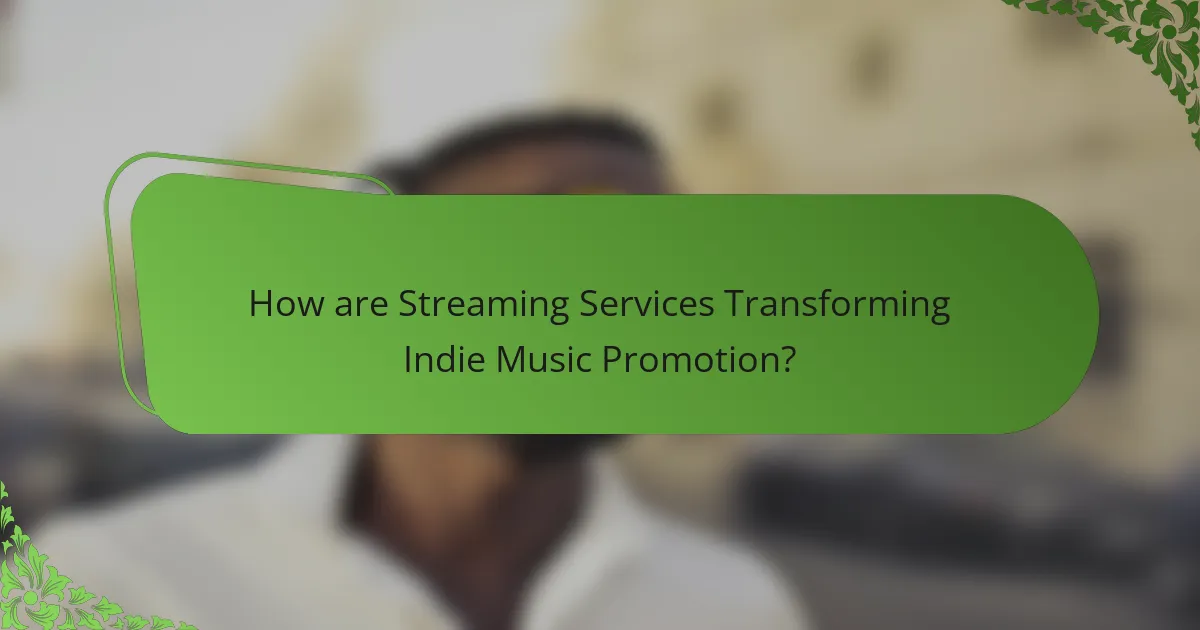
How are Streaming Services Transforming Indie Music Promotion?
Streaming services are revolutionising indie music promotion by providing unprecedented access and visibility. These platforms enable independent artists to reach global audiences without traditional barriers.
Key trends show that streaming algorithms prioritise listener engagement, allowing artists to gain traction through curated playlists. As a result, indie musicians can achieve significant exposure with fewer resources compared to conventional methods.
Moreover, data analytics from streaming services offer insights into listener demographics and preferences. This information helps artists tailor their marketing strategies effectively.
Finally, collaborations between indie artists and streaming platforms are becoming more common, creating unique promotional opportunities. These partnerships enhance visibility and allow for innovative promotional campaigns.
What Role Do Playlists Play in Indie Artist Visibility?
Playlists significantly enhance indie artist visibility by curating music for targeted audiences. Streaming services utilise algorithms to promote indie tracks, increasing reach. Playlists often feature emerging artists, providing essential exposure. As a result, indie musicians can build a following and gain traction in competitive markets.
How Do Streaming Algorithms Affect Music Discovery?
Streaming algorithms significantly enhance music discovery by personalising recommendations based on user preferences. These algorithms analyse listening habits, enabling indie artists to reach targeted audiences more effectively.
As streaming services evolve, they increasingly prioritise data-driven insights. For instance, playlists curated by algorithms often showcase lesser-known artists alongside mainstream hits. This trend boosts visibility for indie musicians, fostering a more diverse music landscape.
Moreover, streaming platforms provide analytics that help artists understand their audience better. Metrics such as listener demographics and geographic data inform marketing strategies, allowing indie musicians to tailor their promotional efforts.
In conclusion, streaming algorithms play a crucial role in promoting indie music, creating opportunities for emerging artists to thrive in a competitive market.
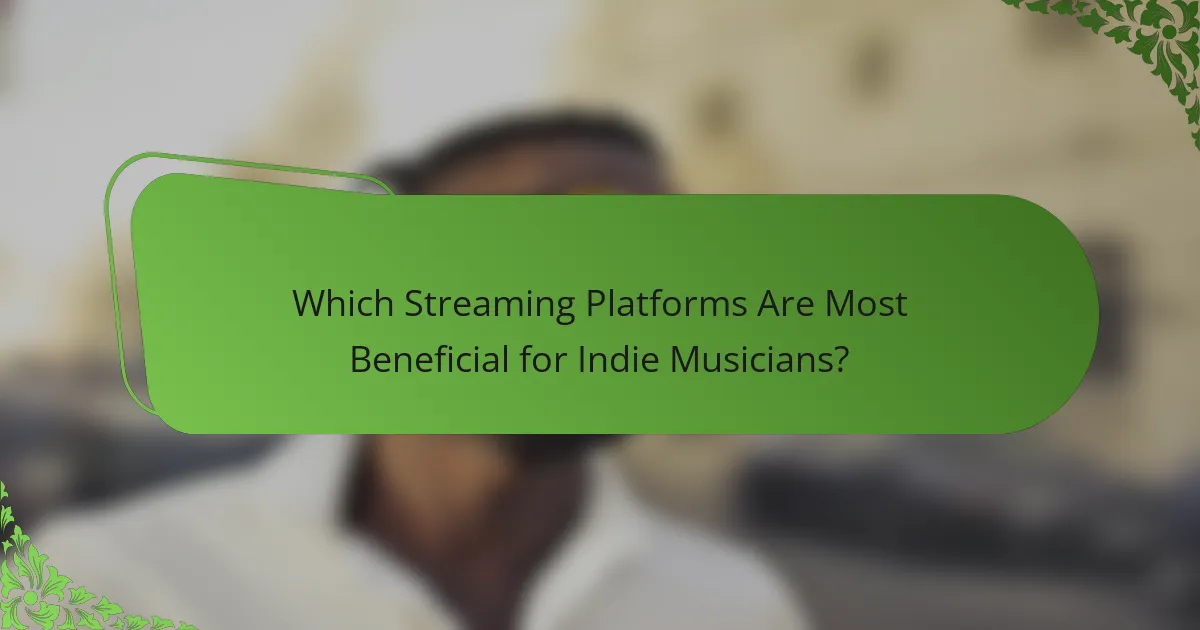
Which Streaming Platforms Are Most Beneficial for Indie Musicians?
Spotify, Bandcamp, and SoundCloud are the most beneficial streaming platforms for indie musicians. These platforms offer unique features that enhance music promotion and audience engagement.
Spotify provides extensive playlists and algorithm-driven recommendations, helping artists reach a wider audience. Bandcamp allows musicians to sell their music directly and engage with fans through merchandise options. SoundCloud features a community-driven platform where artists can share tracks and receive feedback, fostering a supportive environment.
In 2023, Spotify had over 500 million users, while Bandcamp reported that artists earned over $50 million in 2022. SoundCloud boasts a strong creator community with over 76 million tracks available. These metrics highlight the significant impact these platforms have on indie music promotion.
What Are the Unique Features of Bandcamp for Indie Artists?
Bandcamp offers unique features that empower indie artists in music promotion. It allows artists to set their own pricing, fostering direct sales and revenue control. Additionally, Bandcamp provides a platform for artists to showcase their entire discography, enhancing discoverability. The site supports high-quality audio formats, appealing to audiophiles. Artists can engage with fans through messaging and updates, building a dedicated community. Furthermore, Bandcamp’s integrated merch sales facilitate additional revenue streams, a rare feature among streaming services.
How Does Spotify’s Artist Services Support Emerging Talent?
Spotify’s Artist Services significantly support emerging talent by providing tools and resources for promotion. These services include playlist placements, marketing support, and data analytics, which help artists reach wider audiences.
The platform offers tailored promotional campaigns that enhance visibility. For instance, Spotify’s editorial playlists are crucial for indie artists, as they can lead to millions of streams. Additionally, the Artist Dashboard provides insights into listener demographics and engagement, enabling artists to refine their strategies.
Emerging artists benefit from Spotify’s partnerships with social media platforms, facilitating cross-promotion. As a result, artists can leverage their existing fan bases to grow their reach. Moreover, Spotify’s commitment to diversity in music allows for a broader representation of indie genres, fostering a more inclusive music scene.
In summary, Spotify’s Artist Services create a robust ecosystem for emerging talent, enhancing their chances of success in the competitive music industry.
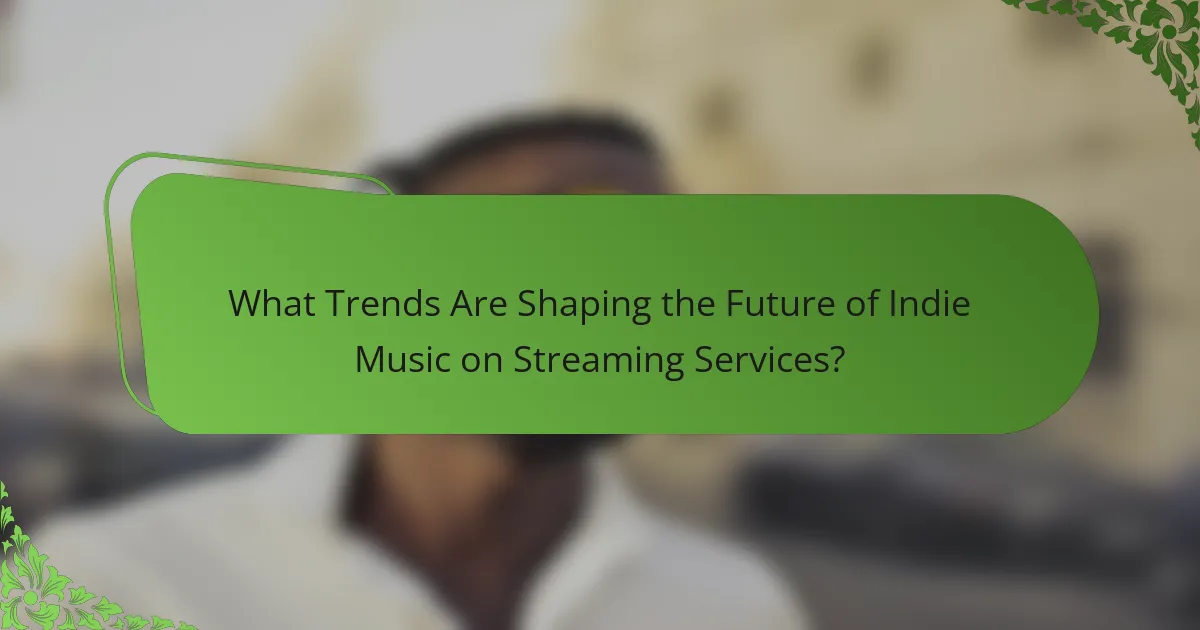
What Trends Are Shaping the Future of Indie Music on Streaming Services?
Streaming services are significantly shaping the future of indie music promotion through innovative trends. One major trend is the rise of algorithm-driven playlists, which enhance discoverability for indie artists. These curated lists often feature emerging talent, allowing them to reach wider audiences. Another trend is the increasing use of data analytics, enabling artists to understand listener preferences and tailor their marketing strategies effectively. Additionally, collaborations between indie artists and established creators are becoming more common, providing mutual benefits and increased visibility. As a result, indie music is thriving on streaming platforms, fostering a diverse musical landscape.
How Are Social Media Integrations Influencing Streaming Success?
Social media integrations significantly enhance streaming success for indie music by increasing visibility and audience engagement. Platforms like Instagram and TikTok allow artists to share their work, reach new listeners, and build communities. These integrations facilitate viral trends, which can propel indie songs to mainstream popularity. For instance, songs featured in viral challenges often see a substantial increase in streaming numbers. Moreover, collaborations with influencers amplify exposure, creating a direct link between social media presence and streaming performance.
What Emerging Genres Are Gaining Popularity on Streaming Platforms?
Emerging genres gaining popularity on streaming platforms include lo-fi hip hop, bedroom pop, and indie folk. These genres thrive due to their accessibility and the ability of artists to reach global audiences without traditional gatekeepers.
Lo-fi hip hop combines soothing beats with nostalgic samples, attracting listeners seeking relaxation and study music. Bedroom pop, characterised by its DIY production and intimate lyrics, resonates with younger audiences. Indie folk’s storytelling elements and acoustic sounds appeal to those valuing authenticity.
Streaming services amplify indie music promotion through curated playlists and algorithmic recommendations. As a result, independent artists gain visibility, leading to increased fan engagement and live performance opportunities.
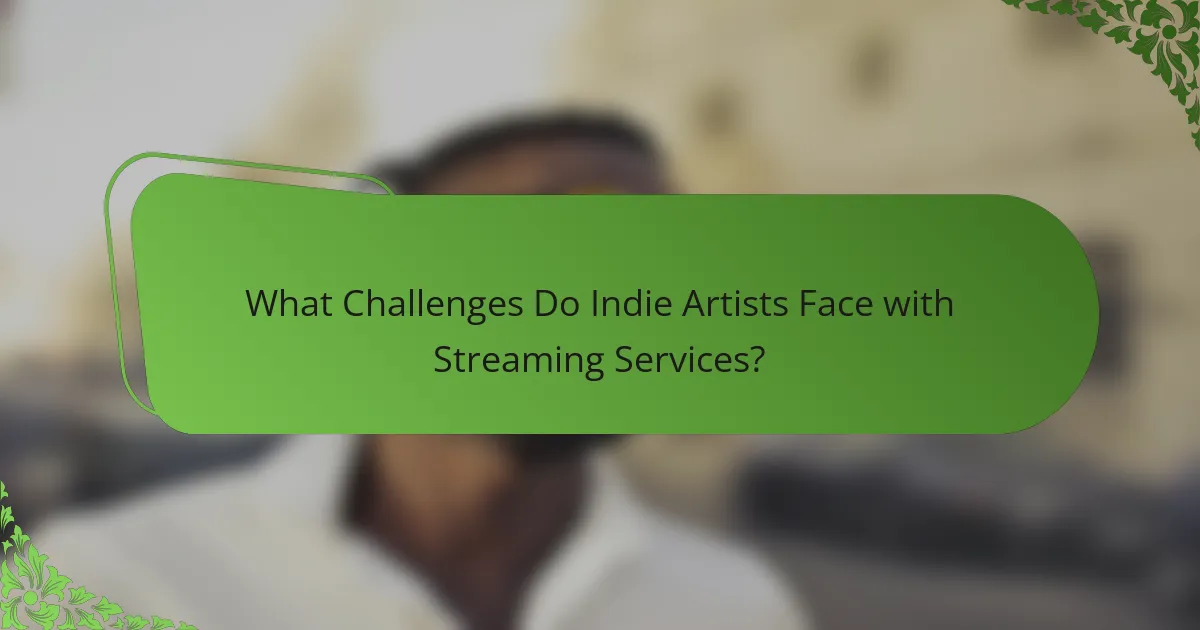
What Challenges Do Indie Artists Face with Streaming Services?
Indie artists face significant challenges with streaming services, primarily due to low revenue and market saturation. Streaming platforms often prioritise major labels, making it difficult for indie musicians to gain visibility. Additionally, the algorithms favour popular tracks, limiting exposure for new or lesser-known artists. This environment creates a competitive landscape where indie artists must invest heavily in marketing to stand out. As a result, many struggle to monetise their work effectively, relying on alternative income sources like merchandise and live performances.
How Do Revenue Models Impact Indie Music Sustainability?
Revenue models significantly influence indie music sustainability by shaping how artists monetise their work. Streaming services have become a primary revenue source, affecting promotional strategies and audience reach.
Indie artists often rely on platforms like Spotify and Apple Music for exposure. These services provide access to vast audiences, but the payout per stream is low. As a result, many indie musicians must supplement income through live performances and merchandise sales.
Moreover, streaming data offers insights into listener demographics and preferences. This information helps artists tailor their marketing efforts, enhancing engagement and fan loyalty. The ability to analyse trends also empowers indie musicians to make informed decisions about collaborations and releases.
Overall, the shift towards streaming has created both opportunities and challenges for indie music sustainability, necessitating adaptive strategies for long-term success.
What Are Common Misconceptions About Streaming Royalties?
Many people mistakenly believe streaming services provide significant income for indie musicians. In reality, streaming royalties are often minimal, with artists earning fractions of a cent per stream. This misconception can lead to unrealistic expectations about revenue. Furthermore, some assume that streaming platforms exclusively promote major labels, overlooking the growing trend of services supporting indie music through curated playlists and algorithmic recommendations.
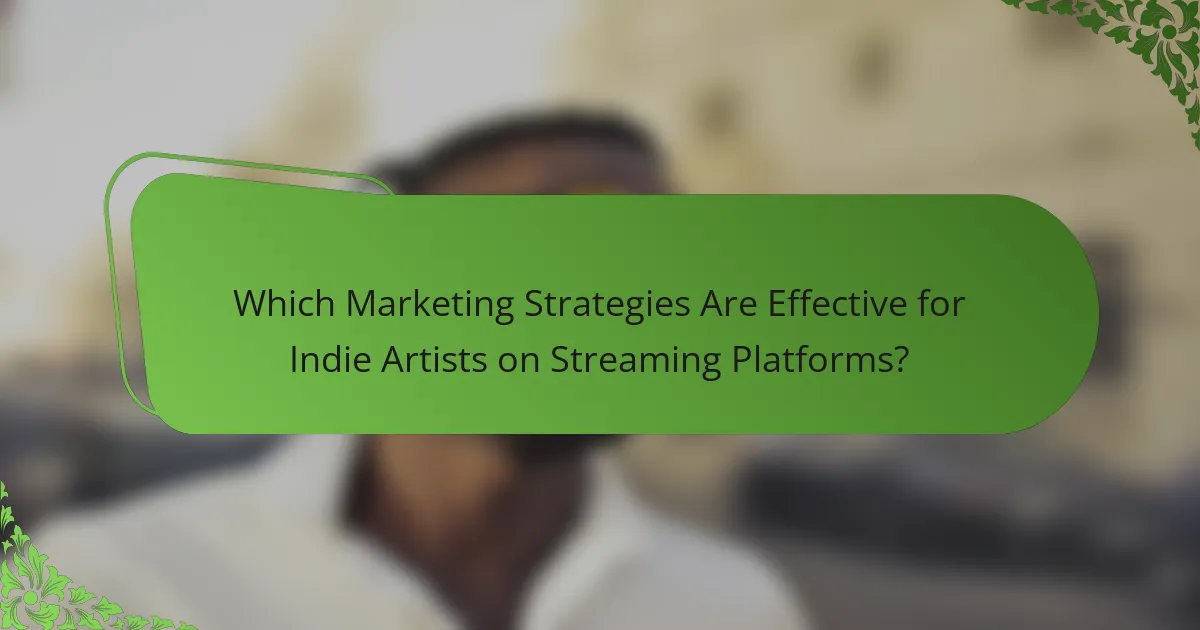
Which Marketing Strategies Are Effective for Indie Artists on Streaming Platforms?
Indie artists can effectively utilise social media marketing, playlist placements, and collaborations to promote their music on streaming platforms. Social media allows direct engagement with fans, building a loyal following. Playlist placements can significantly boost visibility, as curated playlists often reach larger audiences. Collaborations with other artists can introduce indie musicians to new fan bases, enhancing their reach and credibility. These strategies capitalise on the unique attributes of streaming services, such as algorithm-driven recommendations and user-generated content.
How Can Artists Leverage Data Analytics for Better Engagement?
Artists can leverage data analytics to enhance engagement by understanding audience preferences and optimising promotional strategies. Streaming services provide valuable insights into listener demographics, behaviours, and trends. This data helps artists tailor their marketing efforts and identify the most effective platforms for promotion. For instance, tracking play counts and user interactions allows artists to refine their content and release strategies. Additionally, analysing social media engagement can inform targeted campaigns, ultimately fostering a more connected fanbase.
What Best Practices Should Indie Musicians Follow for Promotion?
Indie musicians should leverage streaming services to enhance their promotion strategies. Streaming platforms have transformed music distribution, providing unprecedented access to audiences.
Utilising playlists is crucial; being featured can significantly increase visibility. Data analytics from these services offer insights into listener demographics, enabling targeted marketing. Engaging with fans through social media linked to streaming profiles fosters community and loyalty.
Collaborating with influencers can amplify reach, as their endorsements attract new listeners. Regularly releasing content keeps audiences engaged and encourages algorithmic support from platforms.
Understanding trends, such as the rise of short-form content, allows indie musicians to adapt their promotional strategies effectively.
How Can Collaborations Enhance Streaming Success for Indie Artists?
Collaborations can significantly enhance streaming success for indie artists by expanding their reach and audience. Partnering with other artists or brands introduces new listeners and creates unique content that stands out.
Collaborations can lead to cross-promotion on social media, leveraging each artist’s follower base. This strategy increases visibility and can result in higher streaming numbers. Additionally, joint projects often generate buzz, attracting media attention and playlist placements.
Indie artists can also benefit from shared resources, such as production and marketing support. This collaboration can reduce costs and enhance the quality of the music produced.
Overall, strategic collaborations are vital for indie artists aiming to thrive in the competitive streaming landscape.
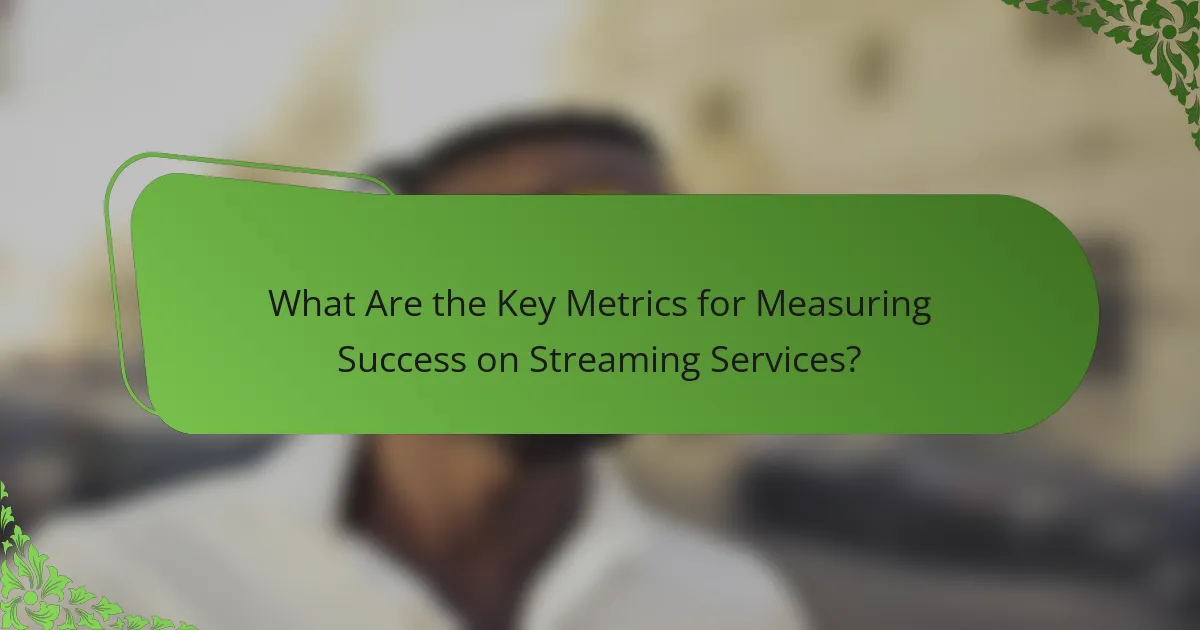
What Are the Key Metrics for Measuring Success on Streaming Services?
Key metrics for measuring success on streaming services include listener engagement, playlist placements, and streaming numbers. These metrics reveal how effectively indie music reaches audiences. Listener engagement can be gauged through likes, shares, and comments. Playlist placements enhance visibility, while streaming numbers indicate overall popularity. These combined insights help artists and labels refine promotional strategies.
How Do Listener Demographics Influence Marketing Strategies?
Listener demographics significantly shape marketing strategies for indie music promotion. Streaming services provide detailed audience insights that guide targeted marketing efforts.
Demographic factors include age, gender, and geographical location. Younger audiences often prefer platforms like Spotify, while older listeners may gravitate towards YouTube or Apple Music. This influences promotional tactics, such as social media campaigns tailored to specific age groups.
Streaming services also offer data on listener behaviour, such as song preferences and listening times. Marketers can leverage this information to create personalised content, enhancing engagement and conversion rates.
As a result, understanding listener demographics allows indie artists to allocate resources effectively, ensuring that marketing strategies resonate with their target audience.
Which Metrics Indicate Growth and Engagement for Indie Artists?
Streaming services provide key metrics indicating growth and engagement for indie artists. Important metrics include streaming numbers, playlist placements, social media interactions, and fan engagement rates.
Streaming numbers reflect the total plays an artist receives, signalling popularity. Playlist placements enhance visibility, driving new listeners. Social media interactions, such as likes and shares, indicate audience engagement. Fan engagement rates, measured through comments and direct messages, reveal the depth of connection with listeners.
These metrics collectively illustrate an indie artist’s growth trajectory and audience engagement levels. Tracking these indicators helps artists refine their promotional strategies effectively.
How Can Indie Artists Optimize Their Streaming Profiles?
Indie artists can optimise their streaming profiles by enhancing their visibility and engagement. Focus on creating high-quality visuals and compelling bios to attract listeners. Utilise data analytics from streaming platforms to understand audience preferences and adjust marketing strategies accordingly. Regularly update profiles with new content, including singles and playlists, to maintain listener interest. Collaborate with other artists to reach wider audiences and leverage social media for cross-promotion. Engaging with fans through live streams or Q&A sessions can also foster a loyal community.
What Expert Tips Can Help Indie Musicians Navigate Streaming Services Effectively?
Indie musicians can navigate streaming services effectively by focusing on targeted promotion strategies. Building a strong online presence through social media and engaging with fans fosters community. Utilising data analytics from streaming platforms helps identify audience preferences and optimise release strategies. Collaborating with playlists and influencers expands reach and visibility. Regularly updating content and maintaining consistency keeps listeners engaged.
